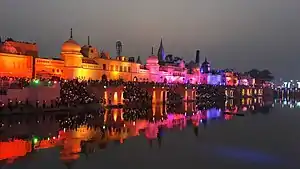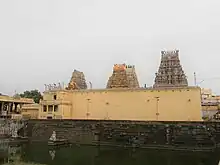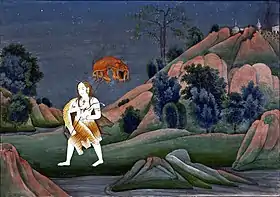| Sri Kamakshi Amman Temple | |
|---|---|
.jpg.webp) Main gopuram (entrance tower) to the temple | |
| Religion | |
| Affiliation | Hinduism |
| District | Kanchipuram district |
| Deity | Kamakshi |
| Location | |
| Location | Kanchipuram Town |
| State | Tamil Nadu |
| Country | India |
| Geographic coordinates | 12°50′26″N 79°42′12″E / 12.840684°N 79.703238°E |
| Architecture | |
| Type | Tamil architecture |
| Sapta Puri |
|---|
 |
The Sri Kamakshi Amman Temple is an ancient Hindu Temple dedicated to the goddess Kamakshi, one of the highest aspects of Adi Parashakti, the mighty goddess in Shaktism. The temple is located in the historic city of Kanchipuram, near Chennai, India. The temple houses one of the 108 Divya Desams of Vishnu and is called Tirukalavanur. The temple is dedicated mainly to Kamakshi and then to Vishnu in his form of Varaha. The temple is glorified by the 6th-9th century Vaishnavite Alvars (Tamil saint poets) in the Naalayira Divya Prabandham. Its construction is credited to the Pallava kings, whose capital was in the same city. This temple, along with the goddesses of Madurai and either Varanasi or Thiruvanaikovil, are the important centers of Shaktism in the state of Tamil Nadu. The present temple is also known as Kamakoti Peetha or Kamakota Nayaki Kovil, where Tripura Sundari had settled after killing a demon. This ancient temple was mentioned in Perunaraatrupadai, an ancient Tamil literature that praises the renowned Sangam era. King Thondaiman Ilandiraiyan of the Pallava dynasty, who ruled Kanchipuram, constructed the temple. Kamakshi is worshipped in the shrine in 5 forms, one of them was a golden idol, which was transported to Thanjavur due to the Muslim invasions of Kanchipuram. There are no other goddess temples in the city of Kanchipuram, apart from this one, which is unusual in a city that has hundreds of traditional temples. There are various legends that account for this fact.
According to a local legend, Adi Shankaracharya established the Sri Yantra in this shrine. The temple is also the center for the Kanchipuram Kamakoti Peetham monastery, with renowned pontiffs such as Chandrashekarendra Saraswati, also known as Maha Periyava, Jayendra Saraswathi and the current pontiff, Vijayendra Saraswati.[1]
Origin
In the Sangam text Perumpanatruppadai, the temple has been mentioned as Kamavelkottam along with Kumarakottam, which was then ruled by the Sangam-era King Thondaiman Ilandiraiyan. In some Hindu scriptures, Kamakshi Amman is considered in line with Meenakshi at Madurai, and Vishalakshi at Varanasi or in some accounts, Akilandeswari at Thiruvanaikovil. Kamakshi is the only Shakti shrine centered across all Shiva temples in Kanchipuram which do not have separate shrines for Goddess Shakti. Kamakshi is praised as 'Sri Mata' (respected mother) as the first name in the Lalitha Sahasranama. Tantric texts such as Tripura Rahasya, Bahvrucha Upanishad, as well as Puranas such Brahmanda Purana and Markandeya Purana discuss how Tripura Sundari resides in Kanchipuram.[2]
According to mythology, The gods were tormented by a demon, Bhandasura and the gods performed penance to appease the goddess Adi Parashakti in the form of parrots, perching on champaka trees at the temple, since parrots always perch on the right hand of the goddesses Meenakshi and Kamakshi. Pleased with their penance, the goddess is said to have appeared through the Bila gate and killed Bhandasura. The idol of Kamakshi has been described as representing her three forms: Sthula (symbolizing Dhyana and Yoga), Sukshma (symbolizing Mantra and Yantra), and Karana or Vasanatmaka. It is also said that Shiva, the inseparable husband of Shakti worshipped the goddess in the four yugas assuming the forms of the sages Krodha Bhattaraka in the Satya Yuga, Parashurama in the Treta Yuga, Dhaumya in the Dwapara Yuga, and Adi Shankara in the Kali Yuga. The Bila gate leading to the Bilakasha tree can be seen today in front of the Tapa Kamakshi shrine inside the sanctum. It is also said that Shiva assumed the form of Durvasa on her emergence from the tree and first worshipped her by chanting the Sri Vidya Tantra and consecrating a huge structure of the Sri Yantra in a yoni shaped trough, in-front of the Kamakshi idol. Durvasa is thus the traditional teacher of Sri Vidya and Adi Shankara is credited for consecrating the current Sri Yantra sculpture. The deities who composed the Lalita Sahasranama can be seen around the Sri Yantra in the same positions as depicted in Manidvipa, the mythological abode of Kamakshi. A shrine dedicated to Hayagriva, an avatar of Vishnu and the sage Agastya can be seen in the third enclosure of the temple, at the location where Agastya learned the Lalita Sahasranama from Hayagriva.[3]
Architecture
The temple occupies an area of 5 acres (2.0 ha). The sanctum houses the image of Kamakshi in a seated posture and is flanked by the trinity of Shiva, Vishnu, and Brahma. There are smaller shrines of Bangaru (Golden) Kamakshi, Adi Shankara. and Saraswati around the sanctum.[2] The picture provides a glimpse view of the Temple Pond (pushkarini) and Elephant Shed. Every day the temple rituals start with the Gau (sacred cow) Pooja and Gaja (elephant) Pooja. There is a separate shed with elephants, which performs pooja to the deity by trumpeting every day early morning at 5 AM. In front of the sanctum, there is a Gayatri Mandapam to the right of the shrine we can see the deities Arupa Lakshmi and Swarupa Lakshmi. The temple is maintained and administered by the Hindu Religious and Charitable Endowments Department of the Government of Tamil Nadu.[4] The idol in the Adi Kamakshi temple which is close to the current Kamakshi temple, is called by various names like Kirtimati, Devagarbha in extant Tantric works like Tantrachudamani. She has four hands containing in each of them respectively, goad, noose, Abhayamudra, and a bowl, similar to the depictions of the goddesses Mariamman and Karumari. This description corresponds to those extant old tantric works.
Festivals
Four worship services are offered each day. The annual festival falls in Spring, in the Tamil month of Masi, which runs from mid-February to mid-March. During this Mahotsavam, the most important day to be celebrated is Maasi Pooram, which is the Avirbhava dhina of Lalitha Maha Tripura Sundari in Kanchi. Other than that, the chariot festival (Ther) and float festival, (Theppam) are held.[1] Other festivals include Navaratri, Aadi and Aippasi Pooram, Sankara Jayanthi and Vasanta Utsavam in the Tamil month of Vaikasi. All Fridays are considered sacred, though the Fridays in the Tamil months of Adi (mid-July to mid-August) and Thai (mid-January to mid-February) are celebrated.
Shrines

Goddess Kamakshi is worshipped in the shrine in five forms:
- Shri Kamakshi Para Bhattarika – Kamakshi is the main deity of the temple. The idol is seated in the center of the inner sanctum of the shrine from the Gayatri Mandapa. According to the test Kamakshi Rahasya, this hall was built by the celestials with the four walls representing the four Vedas and the twenty-four pillars representing the twenty-four syllables of the Gayatri Mantra. The idol, which forms the inner core of the Gayatri Hall, is enshrined at the center of the hall as Kamakshi. She is seated on a throne made from the five Brahmas and sports in her four hands a noose, goad, a sugarcane bow, and flower arrow. The idol is depicted seated in the Padmasana (Lotus pose) and faces south-east.
- Tapa Kamakshi – This form of Kamakshi can be seen to the right of the main idol and close to the Bila gate. Legend says that Parvati was separated from Shiva, and appeared first as Annapurneshwari in either Varanasi or Horanadu and then following the advice of sage Katyayana, moved to Kanchipuram to worship Shiva as Ekambareswara under the mango tree near the Vegavati river and married him.
- Anjana Kamakshi – Also known as Arupa Lakshmi (formless Lakshmi), her shrine is situated to the left of the main idol, facing the north and in front of the Saubhagya Ganapati shrine. According to legend, Lakshmi, due to a curse, is said to have performed penance on her husband Vishnu's insistence to regain her lost beauty in this place and, due to the incident, a Lakshmi shrine was built and offerings of kumkuma are offered to her here before being accepted by the devotees. While she represents Lakshmi in her form as Lakshmi Bija, she represents Kamakshi in the form of Kamakalakshara which is inherent in the Lakshmi shrine.
- Swarna (Golden) Kamakshi – The shrine of this deity, also known as Bangaru Kamakshi in Telugu, is situated in the second enclosure. It is said that this form was created by Kamakshi herself, from her third eye to serve as the consort of Shiva as Ekambareswara. After marrying Shiva, she was known as Goddess Elavarkuzhali. The original idol that appeared is seen today in Thanjavur. The golden idol was transported to Thanjavur by Kamakshi Dasa, in the wake of Muslim invasions. The current idol is made of panchaloha, an alloy of 5 metals.
- Utsava Kamakshi – The shrine of Utsava Kamakshi, the idol which is brought out during processions, is located in the second enclosure. The idol is accompanied on either side by idols of Saraswati and Lakshmi. While the gods and goddesses are generally accompanied by their consorts in most cases, on account of Kamakshi being powerful than Shiva, there is no shrine for Shiva here. Tripura Sundari, who appeared from the fire for the destruction of Bhandasura, was presented to the world by Brahma with the name Kamakshi. Thus, Kamakshi is the special epithet of the goddess. As she brings joy to the mind of Shiva alias Kameshwara, she is referred to as Kameshwari.
Significance

In front of the main shrine, is the shrine of Durvasa, considered to be an avatar of Shiva. There are thirty-two chief assistants of the goddess eg. Surya, Chandra, Kubera, etc. Among these, Kamadeva, Lopamudra and Durvasa are the chief assistants. Durvasa represents the sattva power of the goddess, used to protect and correct her devotees, and thus her limitless power and grace. It is Durvasa who is believed to have established the shrine by consecrating a Sri Yantra in front of the idol. He composed the Lalita Stavaratna, also called the Arya Dwishati, describing Manidvipa, the abode of Kamakshi. He also composed the Tripura Mahimna Stotra, a complete shastra in itself, and also the Para Shambho Mahima Stotra. Due to a curse by Saraswati, he was born as a deaf and mute man and was graced by Kamakshi with Anugraha Diksha, relieving a part of his curse.
Shakti Peetha

The ancient story of Daksha yajna and Sati's self-immolation is the main theme in the origin of Shakti Peethas.[5]
Shakti Peethas are the divine temples of Adi Parashakti. The cause of the presence of the goddess is due to the falling of body parts of the corpse of Sati, Shiva's first wife. The navel part of Sati's body is believed to have fallen here in Kanchipuram, giving the name Nabhi Peetham. There are 51 Shakti Peethas linked to the 51 alphabets in Sanskrit, out of which 18 are the most visited.[1][6]
Tirukkalvanur Divya Desam
In the temple, the Tirukkalvanur Divya Desam, the temple dedicated to Vishnu in his form of Varaha is present. The original temple was a little further from the Kamakshi temple and due to the ruined state of the old shrine, the deity is now placed inside the Kamakshi temple, in the belief that Vishnu is the brother of Kamakshi.[7]
References
- 1 2 3 Harshananda, Swami (2012). Hindu Pilgrimage Centres (second ed.). Bangalore: Ramakrishna Math. p. 61. ISBN 978-81-7907-053-6.
- 1 2 Diwakar, Macherla (2011). Temples of South India (1st ed.). Chennai: Techno Book House. p. 140. ISBN 978-93-83440-34-4.
- ↑ V., Meena (1974). Temples in South India (1st ed.). Kanniyakumari: Harikumar Arts. p. 41.
- ↑ "Thirukoil - Temple list of Tamil Nadu" (PDF). Hindu Religious & Charitable Endowments Department, Government of Tamil Nadu. p. 244.
- ↑ "Kottiyoor Devaswam Temple Administration Portal". Kottiyoor Devaswam. Retrieved 20 July 2013.
- ↑ "www.kamakoti.org/".
- ↑ South Indian shrines: illustrated P.539.P. V. Jagadisa Ayyar

